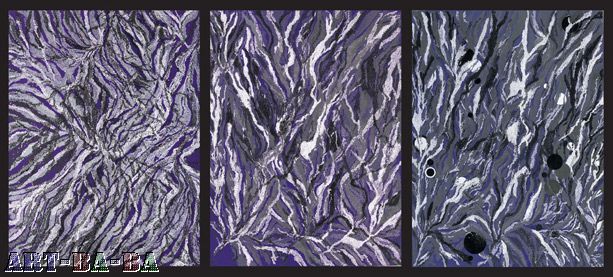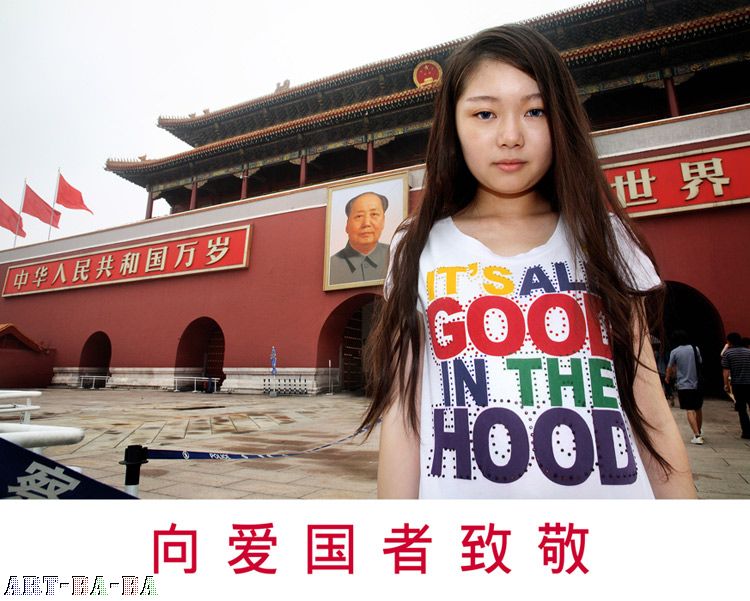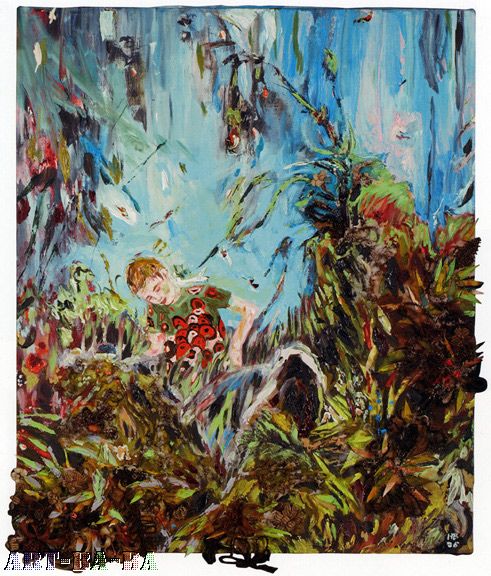A Soft Landing at Frieze?
Courtesy the artist and Hauser & Wirth
Bharti Kher's triptych made from bindi dots, "I'm going that way" (2008), sold for €300,000 at Hauser & Wirth's booth.

LONDON—Things started off on an ominous note at the Frieze Art Fair today. As collectors on the top tier of the VIP list lined up at 11 a.m., the sound of thunder came intermittently over the fair's PA system, a special project by the Czech artist Pavel Büchler. But by the end of the day, a mood of cautious optimism reigned. Collectors took their time making decisions, rather than snapping up works in a feeding frenzy, as has been the modus operandi for the past several years of this booming market. This year, Frieze’s preview day was more about reserves than sales. And it was also about putting a happy face on things; it was sometimes hard to tell if dealers were being euphemistic or obtuse.
"It's subdued," said New York and Berlin dealer Robert Goff, who is not showing in the fair.
"It's reserved," said art adviser Sandy Heller. "But that's not so bad. It gives you the ability to contextualize things, to think about their meaning."
One question on dealers' minds was whether Americans would show up. But New York collectors Susan and Michael Hort were spotted, as were Joel and Sherry Mallin, Jason Rubell, and Adam Lindemann. Asked what implications the credit crisis might have for the art world, Lindemann said simply, "It's a different market. It has its own rules."
In general, the major players seemed to come out in force. Spotted around the preview was everyone from critic Jerry Saltz to artist Ai Weiwei to design dealer Murray Moss to Todd Levin, adviser to American collector Adam Sender. There were also the requisite celebrity sightings. Actress Gwyneth Paltrow, casually dressed and seemingly free of make-up, made an appearance, as did singer George Michael. Adam Clayton of U2 was spotted with his adviser, deliberating over a €15,000 ($20,190) abstract painting by Stefan Bruggeman at Yvon Lambert.
Lisa Dennison, a former director of the Guggenheim Museum who is now executive vice president for Sotheby’s North America, said she had been walking around with a group of contemporary collectors from Europe and America and finding that "in the first half hour of the fair, there have been strong sales of both younger and more established artists, from Robert Gober and Louise Bourgeois to Anselm Reyle and Josiah McElheny. It's encouraging." She also said she was seeing a lot of American collectors.
By early afternoon, London and Zurich gallery Hauser & Wirth had parted with a number of works. A painting by Indian artist Subodh Gupta went for €450,000. A painting by Polish artist Wilhelm Sasnal went for €60,000. A triptych by Indian artist Bharti Kher, made from bindi dots, went for €300,000, and Paul McCarthy's sculpture Mad House Red/Black, made in 2008 but belonging to the "Propo" series (1972–94), went for $160,000.
If the fair started slowly at the 11 a.m. super-VIP entrance — indeed, some with regular VIP badges instead of the fancy 11 a.m. ones found themselves queuing in the rain at 1:45 p.m. — by 3 or 4 p.m. things were heating up, and by evening the aisles were packed. The energy had changed.
By that time, crowds were filing past the life-size Antony Gormley sculpture of a human figure standing at the entrance to Paris and Salzburg dealer Thaddeus Ropac's booth. "If you'd asked me this morning, I would say we were preparing for a slowing of the market," said the dealer. "But after 2:00 p.m., it really picked up. Sales are happening less quickly, but we prefer this. The market is going into a soft landing, and that's what we would wish for." He had sold the Gormley for £220,000 and a painting by Georg Baselitz for €375,000, as well as works by Alex Katz and Tom Sachs.
New York dealer David Zwirner said he thought the fair was going reasonably well, all things considered, but his ratio of reserves to sales on the first day had changed from last year: there were more reserves this year. "People are taking their time making decisions," he said. "But now is not the time to put pressure on." Overall, he said, collectors are feeling insecure. But as the day unfolded and they saw transactions, they began to relax.
At New York dealer Paul Kasmin's booth, director Nicholas Olney said the mood had gotten very good, indeed. They had sold a painting by Ian Davenport and another by Walton Ford. Paul Kasmin chimed in, "It's definitely much quieter, but things are slowly but surely working out." Works tended to sell at the £50,000 price point; the Davenport was roughly that price, and many collectors had inquired about commissioning a piece from sculptor Petroc Sesti, whose commissions run at about £55,000. Sesti’s sculpture, which looks like a large crystal ball, fronted Kasmin’s booth.
At another New York gallery, Lehmann Maupin, Rachel Lehmann said it was "definitely quieter, but we won't really know how things are going until tomorrow." She was able to report several sales, however. A Hernan Bas painting and collage piece sold to a U.S. museum, and a sculpture of a shark by Ashley Bickerton went for between $400–500,000. Lehmann had sold several works by Mickalene Thomas, and others were on reserve. A piece by Teresita Fernandez was also on reserve. Lehmann pointed out that the gallery is giving clients more time to pay.
Established London dealer Leslie Waddington brought older secondary market blue-chip works by Richard Hamilton and others, but the works that were selling in his stand were on the more affordable end of things, such as two paintings by Ian Davenport. On his way out for the day, Waddington commented that for the first time in many years, "I really don't know what will happen, and I don't think anyone else knows either." Like many dealers, he said that this year buyers know they have time to make up their minds.
Paris-, New York–, and now London-based dealer Yvon Lambert ended up having a relatively good day, selling a new painting by Carlos Amorales for $45,000 to, as director Cornelia Tischmacher put it, "an important American collector," among other sales. Tischmacher said the fair this year was less about making contact with and doing business with "eager new clients" and more about selling to familiar, dedicated collectors.
But what was happening in the lower price registers? New York gallery CRG has a booth full of new color photographs, modeled on Maoist propaganda images, by O Zhang, a young Chinese artist based in New York. Smaller pieces were priced at $6,000, while a larger, unique one was offered for $18,000. Director Alex Dodge said that they had sold four or five of the smaller ones. They had also sold some things from their back room. Dodge reported seeing some important American collectors and said dealers were "doing well. Not great, but well enough to afford to be here."
"When the market drops, then makes a huge gain, you don't know what to think, or how it will affect the art market," he said. But so far, things seemed fine.
"Dealers were nervous yesterday, talking about what would happen," said the laid-back San Francisco and New York dealer Jack Hanley, sitting in an enclosed room in his booth filled with works by young artists. "I got here late today, and by that time collectors were fighting over stuff." Behind him were 18 drawings by American artist Ajit Chauhan, some priced for as little as $600. They had all sold to the same London collector.
Lorenzo Rudolf, onetime director of Art Basel and presently director of Shanghai's ShContemporary fair, said after a half hour at Frieze that it seemed to be going better than people had predicted. "Top quality works at reasonable prices are selling," he ob
Bharti Kher's triptych made from bindi dots, "I'm going that way" (2008), sold for €300,000 at Hauser & Wirth's booth.

LONDON—Things started off on an ominous note at the Frieze Art Fair today. As collectors on the top tier of the VIP list lined up at 11 a.m., the sound of thunder came intermittently over the fair's PA system, a special project by the Czech artist Pavel Büchler. But by the end of the day, a mood of cautious optimism reigned. Collectors took their time making decisions, rather than snapping up works in a feeding frenzy, as has been the modus operandi for the past several years of this booming market. This year, Frieze’s preview day was more about reserves than sales. And it was also about putting a happy face on things; it was sometimes hard to tell if dealers were being euphemistic or obtuse.
"It's subdued," said New York and Berlin dealer Robert Goff, who is not showing in the fair.
"It's reserved," said art adviser Sandy Heller. "But that's not so bad. It gives you the ability to contextualize things, to think about their meaning."
One question on dealers' minds was whether Americans would show up. But New York collectors Susan and Michael Hort were spotted, as were Joel and Sherry Mallin, Jason Rubell, and Adam Lindemann. Asked what implications the credit crisis might have for the art world, Lindemann said simply, "It's a different market. It has its own rules."
In general, the major players seemed to come out in force. Spotted around the preview was everyone from critic Jerry Saltz to artist Ai Weiwei to design dealer Murray Moss to Todd Levin, adviser to American collector Adam Sender. There were also the requisite celebrity sightings. Actress Gwyneth Paltrow, casually dressed and seemingly free of make-up, made an appearance, as did singer George Michael. Adam Clayton of U2 was spotted with his adviser, deliberating over a €15,000 ($20,190) abstract painting by Stefan Bruggeman at Yvon Lambert.
Lisa Dennison, a former director of the Guggenheim Museum who is now executive vice president for Sotheby’s North America, said she had been walking around with a group of contemporary collectors from Europe and America and finding that "in the first half hour of the fair, there have been strong sales of both younger and more established artists, from Robert Gober and Louise Bourgeois to Anselm Reyle and Josiah McElheny. It's encouraging." She also said she was seeing a lot of American collectors.
By early afternoon, London and Zurich gallery Hauser & Wirth had parted with a number of works. A painting by Indian artist Subodh Gupta went for €450,000. A painting by Polish artist Wilhelm Sasnal went for €60,000. A triptych by Indian artist Bharti Kher, made from bindi dots, went for €300,000, and Paul McCarthy's sculpture Mad House Red/Black, made in 2008 but belonging to the "Propo" series (1972–94), went for $160,000.
If the fair started slowly at the 11 a.m. super-VIP entrance — indeed, some with regular VIP badges instead of the fancy 11 a.m. ones found themselves queuing in the rain at 1:45 p.m. — by 3 or 4 p.m. things were heating up, and by evening the aisles were packed. The energy had changed.
By that time, crowds were filing past the life-size Antony Gormley sculpture of a human figure standing at the entrance to Paris and Salzburg dealer Thaddeus Ropac's booth. "If you'd asked me this morning, I would say we were preparing for a slowing of the market," said the dealer. "But after 2:00 p.m., it really picked up. Sales are happening less quickly, but we prefer this. The market is going into a soft landing, and that's what we would wish for." He had sold the Gormley for £220,000 and a painting by Georg Baselitz for €375,000, as well as works by Alex Katz and Tom Sachs.
New York dealer David Zwirner said he thought the fair was going reasonably well, all things considered, but his ratio of reserves to sales on the first day had changed from last year: there were more reserves this year. "People are taking their time making decisions," he said. "But now is not the time to put pressure on." Overall, he said, collectors are feeling insecure. But as the day unfolded and they saw transactions, they began to relax.
At New York dealer Paul Kasmin's booth, director Nicholas Olney said the mood had gotten very good, indeed. They had sold a painting by Ian Davenport and another by Walton Ford. Paul Kasmin chimed in, "It's definitely much quieter, but things are slowly but surely working out." Works tended to sell at the £50,000 price point; the Davenport was roughly that price, and many collectors had inquired about commissioning a piece from sculptor Petroc Sesti, whose commissions run at about £55,000. Sesti’s sculpture, which looks like a large crystal ball, fronted Kasmin’s booth.
At another New York gallery, Lehmann Maupin, Rachel Lehmann said it was "definitely quieter, but we won't really know how things are going until tomorrow." She was able to report several sales, however. A Hernan Bas painting and collage piece sold to a U.S. museum, and a sculpture of a shark by Ashley Bickerton went for between $400–500,000. Lehmann had sold several works by Mickalene Thomas, and others were on reserve. A piece by Teresita Fernandez was also on reserve. Lehmann pointed out that the gallery is giving clients more time to pay.
Established London dealer Leslie Waddington brought older secondary market blue-chip works by Richard Hamilton and others, but the works that were selling in his stand were on the more affordable end of things, such as two paintings by Ian Davenport. On his way out for the day, Waddington commented that for the first time in many years, "I really don't know what will happen, and I don't think anyone else knows either." Like many dealers, he said that this year buyers know they have time to make up their minds.
Paris-, New York–, and now London-based dealer Yvon Lambert ended up having a relatively good day, selling a new painting by Carlos Amorales for $45,000 to, as director Cornelia Tischmacher put it, "an important American collector," among other sales. Tischmacher said the fair this year was less about making contact with and doing business with "eager new clients" and more about selling to familiar, dedicated collectors.
But what was happening in the lower price registers? New York gallery CRG has a booth full of new color photographs, modeled on Maoist propaganda images, by O Zhang, a young Chinese artist based in New York. Smaller pieces were priced at $6,000, while a larger, unique one was offered for $18,000. Director Alex Dodge said that they had sold four or five of the smaller ones. They had also sold some things from their back room. Dodge reported seeing some important American collectors and said dealers were "doing well. Not great, but well enough to afford to be here."
"When the market drops, then makes a huge gain, you don't know what to think, or how it will affect the art market," he said. But so far, things seemed fine.
"Dealers were nervous yesterday, talking about what would happen," said the laid-back San Francisco and New York dealer Jack Hanley, sitting in an enclosed room in his booth filled with works by young artists. "I got here late today, and by that time collectors were fighting over stuff." Behind him were 18 drawings by American artist Ajit Chauhan, some priced for as little as $600. They had all sold to the same London collector.
Lorenzo Rudolf, onetime director of Art Basel and presently director of Shanghai's ShContemporary fair, said after a half hour at Frieze that it seemed to be going better than people had predicted. "Top quality works at reasonable prices are selling," he ob

Courtesy the artist and CRG
CRG gallery from New York was selling O Zhang's "Salute to the Patriot" (2008) for $6,000.

New York gallery Lehmann Maupin sold Hernan Bas's "Lost" (2006) to a U.S. museum.